William 'Billy' Haines (1900–1973) was an American film actor and interior designer. By the end of the silent era, he was regularly named as the no. 1 male box-office draw of Hollywood. His career was cut short by the 1930s due to his refusal to deny his homosexuality. Haines quit acting in 1935 and started a successful interior design business with his life partner Jimmie Shields.

British postcard in the 'Famous Cinema Stars' series by Beagles Postcards, no. 237. N. Photo: Metro-Goldwyn-Mayer (MGM).
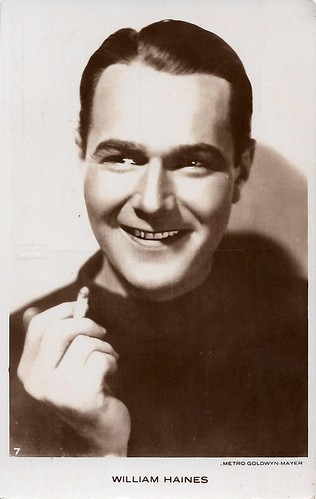
Dutch postcard by Jospe, Arnhem, no. 7. Photo: Metro-Goldwyn-Mayer.

German postcard by Ross-Verlag, no. 4756/1, 1929-1930. Photo: Metro-Goldwyn-Mayer Pictures.

German postcard by Ross Verlag, no. 5350/1, 1930-1931. Photo: Metro-Goldwyn-Mayer. William Haines in Way Out West (Fred Niblo, 1930). Collection: Geoffrey Donaldson Institute.
Charles William Haines was born in 1900 in Staunton, Virginia. 'Billy' was the third child of George Adam Haines, a cigar maker, and Laura Virginia Haines (née Matthews). At an early age, he became fascinated with stage performance and motion pictures, spending hours watching early silent films in the local theatres. At the age of 14, he ran off, accompanied by an unidentified young man to whom Haines referred as his 'boyfriend'. The pair went first to Richmond and then to Hopewell. His parents, frantic over his disappearance, tracked him through the police to Hopewell. Haines did not return home with them, remaining instead in Hopewell and sending money back home to help support the family. He remained in Hopewell until most of the town was destroyed by fire in 1915.
Following the bankruptcy of the family business and the mental breakdown of George, Sr., the family moved to Richmond in 1916. Haines returned home in 1917 to help support them. With his father recovered and employed, Haines moved to New York City in 1919, settling into the burgeoning gay community of Greenwich Village. He became friends with such later Hollywood luminaries as designer Orry-Kelly and Cary Grant. He worked a variety of jobs and was for a time the kept man of an older woman before becoming a model. William Haines was an assistant bookkeeper at a New York bond house when he sent in his photograph to the 'New Faces of 1922' contest sponsored by the Samuel Goldwyn Company. He won the contest and the studio signed him to a $ 40-a-week contract. The other winner of the contest was another future film star, Eleanor Boardman.
Haines arrived in Hollywood for his first meeting with Goldwyn Co. studio brass, reportedly waltzed in and announced, "I'm your new prize beauty". His contract shifted to MGM upon the company merger. His career began slowly, as he appeared in extra and bit parts, mostly uncredited. His first significant role was in Three Wise Fools (King Vidor, 1923) with Eleanor Boardman. His performance received positive notices in contemporary reviews, and Haines was offered a choice of four new film roles after the film's success. Although the studio began building him up as a new star, he continued to play unimportant parts at Goldwyn. His career gained more momentum when he was loaned out to Columbia Pictures where he received favourable reviews for his role in The Midnight Express (George W. Hill, 1924).
Haines then was cast in Little Annie Rooney (William Beaudine, 1925) with Mary Pickford, and Brown of Harvard (Jack Conway, 1926). The latter role solidified his screen persona as a wisecracking, arrogant leading man who was forced to eat humble pie sometime before the fadeout. Other popular films with a sports setting were Slide Kelly Slide (Edward Sedgwick, 1927) and Spring Fever (Edward Sedgwick, 1927) with the young Joan Crawford.
On a trip to New York in 1926, Haines met James 'Jimmie' Shields, possibly as a pick-up on the street. Haines convinced Shields to move to Los Angeles, promising to get him work as an extra. The pair soon began living together and viewed themselves as a committed couple. William Haines' string of hits continued with Show People (King Vidor, 1928), costarring Marion Davies. The film is a lighthearted but fast-paced look at Hollywood at the end of the silent film era and both Davies and Haines were wonderful. Till 1932, Haines was a top-five box-office star.
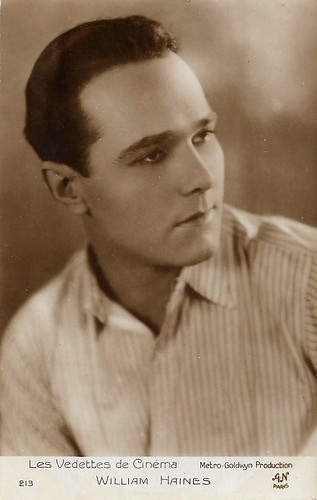
French postcard in the Les Vedettes de Cinéma series by A.N., Paris, no. 213. Photo: Metro-Goldwyn production.

French postcard. Photo: Apeda (Alexander W. Dreyfoos), New York / Metro-Goldwyn.

French postcard by Cinemagazine-Édition, Paris, no. 67. Photo: GMG (Gaumont-Metro-Goldwyn).
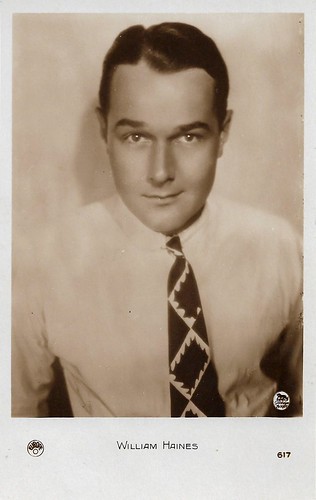
French postcard by Europe, no. 617. Photo: Metro-Goldwyn-Mayer.
When sound film arrived, many Hollywood stars could not make the transition, but William Haines continued to thrive. In fact, Haines was the first MGM star to star in a talkie, the part-sound film Alias Jimmy Valentine (Jack Conway, 1928). His first all-sound film, Navy Blues (Clarence Brown, 1929), was released the following year. He starred in the comedy Way Out West (Fred Niblo, 1930). All of his sound films were successful and studio boss Irving J. Thalberg regarded him as the new model of the male romantic lead for the talking age. Haines was the biggest box-office attraction of 1929 and 1930.
In 1933, Haines was arrested in a YMCA with a sailor he had picked up in Los Angeles' Pershing Square. Louis B. Mayer, the studio head at MGM, allegedly delivered an ultimatum to Haines: Choose between a sham marriage (also known as a 'lavender marriage') or his relationship with his life partner Jimmie Shields. Haines chose Shields and they remained together for almost 50 years. Mayer subsequently fired Haines and terminated his contract. Haines made a few minor films at Poverty Row studios and quit acting in 1935. His final film was The Marines Are Coming (David Howard, 1934) for Mascot Pictures.
Haines and Jimmie Shields started a successful dual career as interior designers and antique dealers. Their first clients were actress Leila Hyams and her husband Phil Berg, Haines' agent. 'Billie' was supported by his friends in Hollywood, like Joan Crawford and Marion Davies. He also did work for Carole Lombard, Claudette Colbert, William Powell, Mr. and Mrs. Fredric March, Joan Bennett, Constance Bennett, and Jack L. Warner. Haines and Shields's lives were disrupted in June 1936 when about 100 members of a white supremacist group dragged the two men from their El Porto, Manhattan Beach home and beat them because a neighbour had accused the two of propositioning his son. The incident was widely reported at the time, but Manhattan Beach police never brought charges against the couple's attackers. The child molestation accusations against Haines and Shields were unfounded and the case was dismissed due to a lack of evidence.
In 1939, paintings were borrowed from Haines’ personal collection to grace the grand plantation home in Gone with the Wind (Victor Fleming, 1939). Haines and Shields refurbished the American ambassador's residence in London and created an interior decoration at the 1939-1940 Golden Gate International Exposition in San Francisco, which boasted a painting by up-and-coming artist Georgia O'Keeffe. The couple finally settled in the Hollywood community of Brentwood and their business prospered until their retirement in the early 1970s, except for a brief interruption when Haines served in World War II. Their clients included Betsy Bloomingdale and Ronald and Nancy Reagan when Reagan was governor of California.
Maintaining a home in Palm Springs, California, Haines never returned to acting but continued to receive offers for film roles. According to IMDb, Haines was approached, along with fellow silent-screen veterans Buster Keaton and Anna Q. Nilsson, to play one of Gloria Swanson's bridge partners in Sunset Blvd. (Billy Wilder, 1950). Swanson herself reportedly asked him to do it. Haines declined and fellow screen veteran H.B. Warner took the part. In 1973, William Haines died of lung cancer, at the age of 73. Almost three months after his death, his lifelong partner Jimmie Shields, broken-hearted, committed suicide with an overdose of sleeping pills. Joan Crawford once called them "the happiest married couple in Hollywood." They are interred side by side in Woodlawn Memorial Cemetery in Santa Monica. Haines' story is told in the 1998 biography 'Wisecracker: The Life and Times of William Haines, Hollywood's First Openly Gay Star' by William J. Mann. William Haines Designs, located in Los Angeles, is carrying on the Haines legacy by faithfully reissuing the original Haines furniture designs.
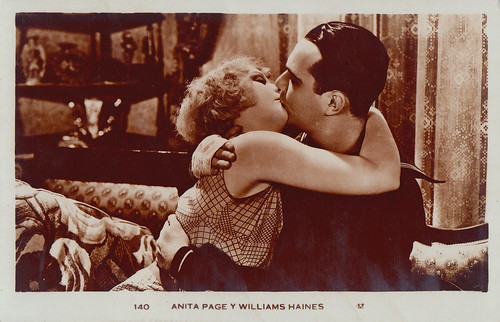
Spanish postcard by MC Barcelona, no. 140. Anita Page and William Haines in Navy Blues (Clarence Brown, 1929). Collection: Marlene Pilaete.
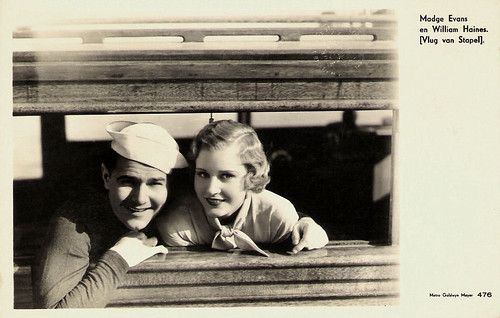
Dutch postcard, Editor unknown, no. 476. Photo: Metro-Goldwyn-Mayer. Publicity still of William Haines and Madge Evans in Fast Life (Harry A. Pollard, Sam Wood, both uncredited, 1932), released in the Netherlands as Vlug van Stapel.

German postcard by Ross Verlag, Berlin, no. 1893/1, 1927-1928. Photo: Fanamet, Metro-Goldwyn-Mayer.
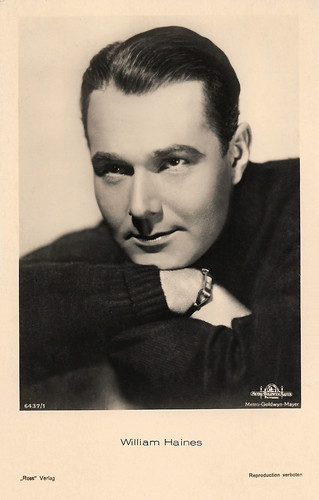
German postcard by Ross Verlag, no. 6437/1, 1931-1932. Photo: Metro-Goldwyn-Mayer (MGM).
Sources: Hal Erickson (AllMovie - page now defunct), Tony Adam (IMDb), William Haines.com, Wikipedia and IMDb.
This post was last updated on 29 July 2024.

British postcard in the 'Famous Cinema Stars' series by Beagles Postcards, no. 237. N. Photo: Metro-Goldwyn-Mayer (MGM).

Dutch postcard by Jospe, Arnhem, no. 7. Photo: Metro-Goldwyn-Mayer.

German postcard by Ross-Verlag, no. 4756/1, 1929-1930. Photo: Metro-Goldwyn-Mayer Pictures.

German postcard by Ross Verlag, no. 5350/1, 1930-1931. Photo: Metro-Goldwyn-Mayer. William Haines in Way Out West (Fred Niblo, 1930). Collection: Geoffrey Donaldson Institute.
The New Face of 1922
Charles William Haines was born in 1900 in Staunton, Virginia. 'Billy' was the third child of George Adam Haines, a cigar maker, and Laura Virginia Haines (née Matthews). At an early age, he became fascinated with stage performance and motion pictures, spending hours watching early silent films in the local theatres. At the age of 14, he ran off, accompanied by an unidentified young man to whom Haines referred as his 'boyfriend'. The pair went first to Richmond and then to Hopewell. His parents, frantic over his disappearance, tracked him through the police to Hopewell. Haines did not return home with them, remaining instead in Hopewell and sending money back home to help support the family. He remained in Hopewell until most of the town was destroyed by fire in 1915.
Following the bankruptcy of the family business and the mental breakdown of George, Sr., the family moved to Richmond in 1916. Haines returned home in 1917 to help support them. With his father recovered and employed, Haines moved to New York City in 1919, settling into the burgeoning gay community of Greenwich Village. He became friends with such later Hollywood luminaries as designer Orry-Kelly and Cary Grant. He worked a variety of jobs and was for a time the kept man of an older woman before becoming a model. William Haines was an assistant bookkeeper at a New York bond house when he sent in his photograph to the 'New Faces of 1922' contest sponsored by the Samuel Goldwyn Company. He won the contest and the studio signed him to a $ 40-a-week contract. The other winner of the contest was another future film star, Eleanor Boardman.
Haines arrived in Hollywood for his first meeting with Goldwyn Co. studio brass, reportedly waltzed in and announced, "I'm your new prize beauty". His contract shifted to MGM upon the company merger. His career began slowly, as he appeared in extra and bit parts, mostly uncredited. His first significant role was in Three Wise Fools (King Vidor, 1923) with Eleanor Boardman. His performance received positive notices in contemporary reviews, and Haines was offered a choice of four new film roles after the film's success. Although the studio began building him up as a new star, he continued to play unimportant parts at Goldwyn. His career gained more momentum when he was loaned out to Columbia Pictures where he received favourable reviews for his role in The Midnight Express (George W. Hill, 1924).
Haines then was cast in Little Annie Rooney (William Beaudine, 1925) with Mary Pickford, and Brown of Harvard (Jack Conway, 1926). The latter role solidified his screen persona as a wisecracking, arrogant leading man who was forced to eat humble pie sometime before the fadeout. Other popular films with a sports setting were Slide Kelly Slide (Edward Sedgwick, 1927) and Spring Fever (Edward Sedgwick, 1927) with the young Joan Crawford.
On a trip to New York in 1926, Haines met James 'Jimmie' Shields, possibly as a pick-up on the street. Haines convinced Shields to move to Los Angeles, promising to get him work as an extra. The pair soon began living together and viewed themselves as a committed couple. William Haines' string of hits continued with Show People (King Vidor, 1928), costarring Marion Davies. The film is a lighthearted but fast-paced look at Hollywood at the end of the silent film era and both Davies and Haines were wonderful. Till 1932, Haines was a top-five box-office star.

French postcard in the Les Vedettes de Cinéma series by A.N., Paris, no. 213. Photo: Metro-Goldwyn production.

French postcard. Photo: Apeda (Alexander W. Dreyfoos), New York / Metro-Goldwyn.

French postcard by Cinemagazine-Édition, Paris, no. 67. Photo: GMG (Gaumont-Metro-Goldwyn).

French postcard by Europe, no. 617. Photo: Metro-Goldwyn-Mayer.
Arrested in a YMCA with a sailor
When sound film arrived, many Hollywood stars could not make the transition, but William Haines continued to thrive. In fact, Haines was the first MGM star to star in a talkie, the part-sound film Alias Jimmy Valentine (Jack Conway, 1928). His first all-sound film, Navy Blues (Clarence Brown, 1929), was released the following year. He starred in the comedy Way Out West (Fred Niblo, 1930). All of his sound films were successful and studio boss Irving J. Thalberg regarded him as the new model of the male romantic lead for the talking age. Haines was the biggest box-office attraction of 1929 and 1930.
In 1933, Haines was arrested in a YMCA with a sailor he had picked up in Los Angeles' Pershing Square. Louis B. Mayer, the studio head at MGM, allegedly delivered an ultimatum to Haines: Choose between a sham marriage (also known as a 'lavender marriage') or his relationship with his life partner Jimmie Shields. Haines chose Shields and they remained together for almost 50 years. Mayer subsequently fired Haines and terminated his contract. Haines made a few minor films at Poverty Row studios and quit acting in 1935. His final film was The Marines Are Coming (David Howard, 1934) for Mascot Pictures.
Haines and Jimmie Shields started a successful dual career as interior designers and antique dealers. Their first clients were actress Leila Hyams and her husband Phil Berg, Haines' agent. 'Billie' was supported by his friends in Hollywood, like Joan Crawford and Marion Davies. He also did work for Carole Lombard, Claudette Colbert, William Powell, Mr. and Mrs. Fredric March, Joan Bennett, Constance Bennett, and Jack L. Warner. Haines and Shields's lives were disrupted in June 1936 when about 100 members of a white supremacist group dragged the two men from their El Porto, Manhattan Beach home and beat them because a neighbour had accused the two of propositioning his son. The incident was widely reported at the time, but Manhattan Beach police never brought charges against the couple's attackers. The child molestation accusations against Haines and Shields were unfounded and the case was dismissed due to a lack of evidence.
In 1939, paintings were borrowed from Haines’ personal collection to grace the grand plantation home in Gone with the Wind (Victor Fleming, 1939). Haines and Shields refurbished the American ambassador's residence in London and created an interior decoration at the 1939-1940 Golden Gate International Exposition in San Francisco, which boasted a painting by up-and-coming artist Georgia O'Keeffe. The couple finally settled in the Hollywood community of Brentwood and their business prospered until their retirement in the early 1970s, except for a brief interruption when Haines served in World War II. Their clients included Betsy Bloomingdale and Ronald and Nancy Reagan when Reagan was governor of California.
Maintaining a home in Palm Springs, California, Haines never returned to acting but continued to receive offers for film roles. According to IMDb, Haines was approached, along with fellow silent-screen veterans Buster Keaton and Anna Q. Nilsson, to play one of Gloria Swanson's bridge partners in Sunset Blvd. (Billy Wilder, 1950). Swanson herself reportedly asked him to do it. Haines declined and fellow screen veteran H.B. Warner took the part. In 1973, William Haines died of lung cancer, at the age of 73. Almost three months after his death, his lifelong partner Jimmie Shields, broken-hearted, committed suicide with an overdose of sleeping pills. Joan Crawford once called them "the happiest married couple in Hollywood." They are interred side by side in Woodlawn Memorial Cemetery in Santa Monica. Haines' story is told in the 1998 biography 'Wisecracker: The Life and Times of William Haines, Hollywood's First Openly Gay Star' by William J. Mann. William Haines Designs, located in Los Angeles, is carrying on the Haines legacy by faithfully reissuing the original Haines furniture designs.

Spanish postcard by MC Barcelona, no. 140. Anita Page and William Haines in Navy Blues (Clarence Brown, 1929). Collection: Marlene Pilaete.

Dutch postcard, Editor unknown, no. 476. Photo: Metro-Goldwyn-Mayer. Publicity still of William Haines and Madge Evans in Fast Life (Harry A. Pollard, Sam Wood, both uncredited, 1932), released in the Netherlands as Vlug van Stapel.

German postcard by Ross Verlag, Berlin, no. 1893/1, 1927-1928. Photo: Fanamet, Metro-Goldwyn-Mayer.

German postcard by Ross Verlag, no. 6437/1, 1931-1932. Photo: Metro-Goldwyn-Mayer (MGM).
Sources: Hal Erickson (AllMovie - page now defunct), Tony Adam (IMDb), William Haines.com, Wikipedia and IMDb.
This post was last updated on 29 July 2024.
No comments:
Post a Comment